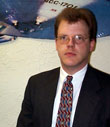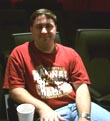Understanding why silver is needed in the analog soundtrack when using "white light" (tungsten exciter lamp) readers requires a little history:Early analog soundheads used gas or vacuum phototubes, which usually had a "S-1" spectral response that peaked at a wavelength of 800 nanometres (infrared). Tungsten bulbs were used as the exciter lamp. Tungsten bulbs produce both visible and infrared light.
Almost all early soundfilms were black-and-white (silver image). Silver efficiently modulates both visible and infrared light (it has "density" to a broad spectrum of energy). So B&W prints worked fine with the tungsten exciter lamps and S-1 response phototubes.
Dyes are relatively "transparent" to infrared energy, so silver was needed to modulate the light in old soundheads. Technicolor dye transfer prints used a special Kodak B&W print film as the "receiver" for its color dyes, so the Technicolor soundtrack was actually a B&W silver image.
When Eastman Color Print film was introduced in 1950, almost all soundheads still used tungsten exciter lamps and S-1 response phototubes. So special steps in the process sequence were developed, requiring TWO fixing baths, and a special viscous soundtrack redeveloper applied to only the soundtrack area to "redevelop" the silver after the process bleach step. The final print soundtrack contained cyan dye, magenta dye and silver, and worked well with tungsten exciter lamps and S-1 phototubes. But the special process steps required to get silver in the soundtrack added to the processing complexity and cost, and were a significant source of laboratory waste and water usage.
The advent of solid state "solar cells" did not significantly change the situation. The silicon cells usually had significant response in the infrared, and lower efficiency in the visible portion of the spectrum. When used with a tungsten exciter lamp, most of the sensitivity was still in the infrared, so silver was still needed. Trying to create a visible-only response with a red filter or cell sensitive to only visible light was not practical, as the efficiencies were poor, and signal levels were much lower.
The invention of high brightness visible red LED light sources for sound readers finally allows the use of cyan dye-only soundtracks, since they have little infrared energy and do not require silver in the soundtrack for efficient modulation. Solid-state red LED readers have significant advantages for theatres, and all new soundheads use red LEDs rather than tungsten exciter lamps.
Eliminating silver from the soundtrack will significantly reduce processing cost and waste, improve print quality, and help the environment (eliminates caustic chemicals, significantly reduces water use in processing, and eliminates silver in discarded prints).
Dye-only (cyan) analog soundtracks REQUIRE the use of red LED sound readers. A dye-only track played with a tungsten exciter lamp will have very low signal levels and very poor signal-to-noise. Dye-only tracks will be implemented when a large majority of theatres are equipped with red LED readers. Implementation is scheduled to begin in the United States in January 2001.
Many prints in release now have "high magenta" analog soundtracks. These tracks have magenta dye + silver, and are more compatible with both tungsten and red LED readers than the previous magenta + cyan + silver tracks. "High Magenta" tracks work well on all readers, but still have silver and the problems associated with it.
The cyan dye tracks being implemented next January will NOT have silver, and will only work well with red LED analog sound readers.
Kodak's website has complete information about dye soundtracks:
http://www.kodak.com/US/en/motion/support/dyetrack.shtml
None of the three current digital sound systems require silver in the soundtrack area, as they were designed to work well with dye only. So no changes are needed for digital sound readers.
------------------
John P. Pytlak, Senior Technical Specialist
Worldwide Technical Services, Entertainment Imaging
Eastman Kodak Company
Research Labs, Building 69, Room 7419
Rochester, New York, 14650-1922 USA
Tel: 716-477-5325 Fax: 716-722-7243
E-Mail: john.pytlak@kodak.com

 Home
Home
 Products
Products
 Store
Store
 Forum
Forum
 Warehouse
Warehouse
 Contact Us
Contact Us




 Printer-friendly view of this topic
Printer-friendly view of this topic

















